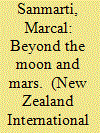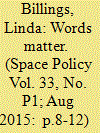|
|
|
Sort Order |
|
|
|
Items / Page
|
|
|
|
|
|
|
| Srl | Item |
| 1 |
ID:
182265


|
|
|
|
|
| Summary/Abstract |
In our immediate solar neighbourhood in space is the Sun and then in order Mercury, Venus, Earth (and its satellite the Moon), Mars (and its satellites Fobos and Deimos) and then a series of asteroids. This is the arena for a growing international effort, both co-operative and competitive, not only in exploration but also in increasingly commercial terms. A race to exploit resources to be found in space, not least in the asteroid belt, is developing. These space activities have both political and economic impact on Earth. Greater collaboration is essential in future, especially to deal with potential dangers from space.
|
|
|
|
|
|
|
|
|
|
|
|
|
|
|
|
| 2 |
ID:
120093


|
|
|
|
|
| Publication |
2012.
|
| Summary/Abstract |
This paper surveys recent and current advancements of laser-induced ablation technology for space-based applications and discusses ways of bringing such applications to fruition. Laser ablation is achieved by illuminating a given material with a laser light source. The high surface power densities provided by the laser enable the illuminated material to sublimate and ablate. Possible applications include the deflection of Near Earth Objects - asteroids and comets - from an Earth-impacting event, the vaporisation of space structures and debris, the mineral and material extraction of asteroids and/or as an energy source for future propulsion systems. This paper will discuss each application and the technological advancements that are required to make laser-induced ablation a practical process for use within the space arena. Particular improvements include the efficiency of high power lasers, the collimation of the laser beam (including beam quality) and the power conversion process. These key technological improvements are seen as strategic and merit greater political and commercial support.
|
|
|
|
|
|
|
|
|
|
|
|
|
|
|
|
| 3 |
ID:
125019


|
|
|
|
|
| Publication |
2013.
|
| Summary/Abstract |
THE BIG METEOR which exploded in an air blast over the Chelyabinsk region on February 15, 2013 was yet another graphic reminder of the real threat to our planet from asteroids and comets. According to the findings of Russian researchers (Institute of Solid-State Physics, Russian Academy of Sciences) announced by Academician Vladimir Fortov, the energy generated by this explosion was equivalent approximately to 400 kilotons of TNT.
|
|
|
|
|
|
|
|
|
|
|
|
|
|
|
|
| 4 |
ID:
142578


|
|
|
|
|
| Summary/Abstract |
The global community of scientists involved in finding and tracking near-Earth asteroids (NEOs), identifying potentially hazardous NEOs, and characterizing the possible effects of asteroid impacts with Earth is developing an awareness of the need to improve and expand efforts to communicate with policy and decision makers about the work they do.
This paper addresses the criticality of clear, concise, correct communications about asteroid impact risks and hazards, as well as proper distinctions among risks, hazards, and actual threats. It reviews recent progress in communication about NEO hazards and impact risks, including new recommendations from expert groups, guidelines for responsible communication about hazards and risks, communication issues raised in collaborations with disaster planners, and other relevant developments.
The next significant asteroid impact with Earth could be 500 years from now, or next week. The need to be prepared for such an event is clear. Policy and decision makers will depend on the community of experts involved in NEO observations and planning for planetary defense for information on the risks and hazards of asteroid impacts with Earth.
|
|
|
|
|
|
|
|
|
|
|
|
|
|
|
|
|
|
|
|
|